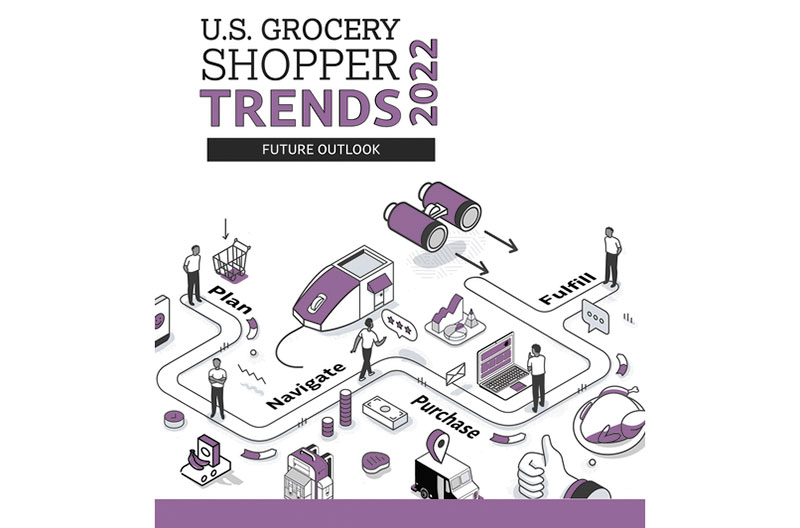by Leslie G. Sarasin, president and CEO, FMI – The Food Industry Association
Sharing a meal with loved ones is among our most physically and emotionally fulfilling daily rituals, perhaps more so in recent years given the upheaval to our routines caused by the COVID-19 pandemic.
As FMI’s recently released U.S. Grocery Shopper Trends 2022 – Future Outlook report confirms, despite a growing return to normalcy for many Americans, shoppers continue to tell us that they plan to maintain their commitment to enjoying family meals together.
According to our research, although the percentage of Americans who say that eating together as a family is extremely important fell slightly from last year, 59 percent still express the view that it is very or extremely important to do so.
What’s more, a full 79 percent of respondents living in households with children rated it very or extremely important to eat together, a level still significantly elevated from soundings taken prior to the pandemic. Commitment to family meals remains high despite our return to more normal patterns in work and school schedules.
Shoppers also indicate they are spending less time preparing meals each day. Nearly three-quarters (74 percent) say it takes less than one hour to prepare their meals, and 30 percent say they spend less than 30 minutes. This is much faster than in recent years.
Additionally, consumer enthusiasm for cooking has declined. As time has progressed, cooking fatigue has set in and fewer shoppers say they love cooking (19 percent now vs. 23 percent in 2021). If we consider these time and convenience factors together, it is clear shoppers desire more easy-to-plan-and-prepare options from food retailers that enable them to continue serving family meals at home.
Given the upheaval to consumer behavior in recent years regarding where they shop, how they shop and what they purchase, the food industry finds itself with an opportunity to cement the gains we have made in the minds of shoppers over the course of the pandemic as solution providers. That could be offering ways to save time and money or providing innovative products that enable Americans to experience more enriching and healthful culinary experiences with their families.
Within the broader food industry ecosystem, independent operators can be – and often have been – at the forefront of this evolution. They have shown impressive determination and creativity in the face of the universal challenges encountered during the last two and a half years, working diligently to ensure they continue to provide their customers with the food and household goods they need at reasonable prices.
Integral to the independent operators’ success is their intimate knowledge of their customers and communities. It is this familiarity factor that equips independent operators to cater more effectively to what their shoppers want.
As we look to the future of food at retail, independent operators can support customers who want to continue eating meals at home with minimal cooking through innovative fresh-prepared, ready-to-eat options and ready-to-prep meal kits.
For customers who still want to purchase ingredients and cook at home, retailers can provide inspiration for meal ideas throughout the store and near related food items. Shoppers looking for savings in fresh categories will best be served by alternatives in adjacent categories rather than “value” versions that imply trading down, while other shoppers will trade up to premium versions when these are framed against pricier restaurant experiences.
Independent operators are strategically situated to leverage the stated consumer preferences for locally produced items and the potential resulting reduction of food waste. They can distinguish themselves by sourcing more fresh products locally or repurposing fresh items into “valued added” products like grab-and-go salads, sides and entrees.
Regardless of the differentiation strategy, food retailers can and should help customers navigate this increasingly challenging inflationary environment as much as possible, which appears likely to persist for the foreseeable future.
As consumers look for ways to save money while also continuing to provide convenient meals at home for their families, grocers have a real opportunity to build brand loyalty through the innovative solutions they offer.
They can help shoppers plan meals in advance with recipe ideas available in store and online, including ways to repurpose leftovers. They can leverage their customer rewards programs to deliver personalized value and recommend frozen produce and meats as alternatives to fresh items.
They can promote private brands that are increasingly seen not just as more economical alternatives, but also as offering similar quality and taste as name brands. They can connect customers with their registered dietitian nutritionists to assist them in identifying healthy options in-store that also align with their budget.
As FMI’s Future Outlook report shows, U.S. grocery shoppers expect food retailers to continue to provide innovative products that help them feed their families in more convenient ways. If the food industry is to build upon the good will accrued over the course of the pandemic in demonstrating to customers that we’re on their side, we must not become complacent just because things are “returning to normal.”
We must continue to join grocery shoppers in their food journeys and offer solutions that meet their evolving needs. If done thoughtfully and strategically, the opportunities that lie ahead for food retailers are boundless.
For more information, visit fmi.org.

